14
Guitar-playing collectors are often eccentric human beings, maybe because you have to be an obsessive to master music. That same obsession might drive you to acquire and hold onto more and more instruments as the years go on. Each instrument does something else. Each has its own tone and feel.
I don’t really know why people do these things. I do know that over the years, I’ve become well versed in dealing with such people. Sometimes you have to just hang out and be patient to win the ever-elusive “gold.”
Back in the seventies, there was always loads of stuff at the Saugus swap meet outside of Los Angeles.
This was back in the era when swap meets were really good, before the dealers took over. They were composed almost entirely of private parties bringing to market high-quality goods. Hard as it might be to believe, the only other outlets to sell were the newspapers or individual garage sales.
I used to get up every Sunday at 4:00 a.m. to make the rounds from swap meet to swap meet. I’d be there so early that I had to bring a flashlight to see what goods were being set up! I would practically sprint from person to person as they were unloading their goods off their trucks or cars.
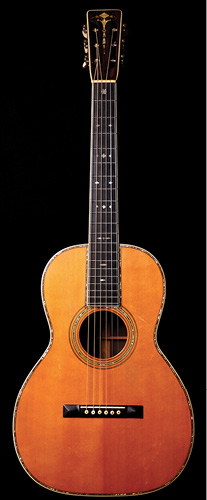
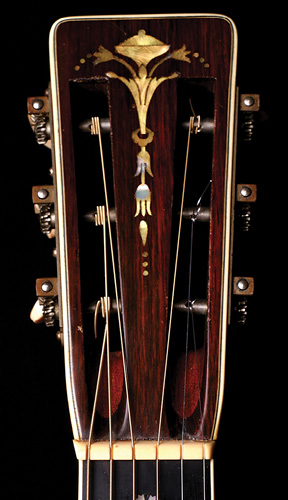
Martin 1928 0-45. (Photos by Jen Angkahan)
Looking back, it’s incredible how much great gear I acquired that way. Living in LA, it was a common occurrence to see old Fenders. Every Sunday I’d see people unloading blond Fender two-piece amps and plenty of tweed cases. I came to realize that those Gibson brown cases almost always contained something special. To many people, these were just old guitars and amps that needed fixing that they wanted to unload. Their value was undocumented, and unknown.
It really was a smorgasbord out there. Often I’d purchase other vintage stuff such as radios, antiques, old suitcases, and the like.
Okay, so maybe I’m one of those obsessives . . .
Over time, all of us regulars became pretty familiar with each other. There was this one old-timer who had been swap-meetin’ from the beginning. He was a tall, good-looking, rangy old cowboy named Don Weston. He must’ve been in his late sixties when I met him, and he used to talk about his experiences as a singing cowboy in movies, and in particular, being Gene Autry’s guitar teacher. This is now pretty much a bygone era of our culture, but the B movie cycles of singing cowboys churned out in volume by Monogram and Republic studios in the forties was a boon to musicians of that ilk. Gene Autry was the king of that world—probably because he invested his earnings as a singing cowboy into TV and radio stations and made a fortune, eventually owning the professional baseball team the California (now Los Angeles) Angels.
Don was one of those journeyman players who backed up Gene, Roy Rogers, Merle Travis, and all the big cowboy stars. A few of his tunes even made it on the Billboard charts in the forties. Of course, by the seventies that world had pretty much evaporated, but he still had a twinkle in his eye when he spoke about it.
Don always had a few guitars displayed, but it seemed to me he was buying more than selling. The guitars he brought to sell were generally no better than average, but I asked if he had more and he said the good stuff was still at home.
“When do I get to see that?” I said.
Don strung me along for a while, then one Sunday he gave me his address in North Hollywood. On the agreed-upon day, I showed up and he showed me a treasure trove of vintage guitars! Old Strats, ES-335s, Gibson archtops, Martin flat-tops, Gretsch 6120s, and hundreds of quality ukuleles, as well as a few banjos and mandolins. He had excellent taste and really knew what was good.
Then Don casually pulled out a brown case, unsnapped the latch, and inside was an unbelievably clean Gibson 1940 Rosewood J-200—a once-in-a-lifetime guitar.
The guitars he amassed over the years were truly amazing, and most were very clean and original. I was practically foaming at the mouth. I tried to keep a poker face, but Don could see right through me. This wasn’t his first time at the rodeo.
I tried to negotiate, but he kept changing the subject, talking about shotguns or old-time saddle makers. He wouldn’t let me get to first base. In retrospect, I think he most enjoyed the fact that I was dying to buy them. It wasn’t a price thing. He just liked tormenting me. He was a true collector and couldn’t bear to part with any of them.
This went on for years. Occasionally he’d sell me some of his more mediocre guitars but wouldn’t let go of the good ones. Being relentless, and not shy about what I wanted, I would call Don approximately every couple months asking, “Have you considered selling me any of your stuff yet?”
“Not at this time,” was always the answer. Don was very polite about it. I couldn’t even get him to quote me a high price, which I probably would have been willing to pay. He knew I had a lot of high-quality guitars, and I think it might have been a competitive thing. We were friendly, but the old rustler viewed it as a contest. He liked me, but he viewed me as Johnny-come-lately. He got off on teasing me.
I remained in contact with Don for probably fifteen years, always asking the same question and getting the same answer. Sadly, after Don passed away, I would occasionally call his wife to ask how she was doing. She knew I really wanted to buy Don’s instruments but she had been so in love with him, she couldn’t get herself to sell them either. I had all but given up on acquiring Don’s things. It was the killer collection that got away.
Some years went by. I went about my business and stopped calling Don’s wife. Then, one day the phone rang, and it was Don’s son on the line. He told me his mom had passed away and before she died, she had instructed him to call me.
It is sad when someone dies and you delve into their collection. It’s a personal glimpse into an individual’s obsessions, private moments, hopes, and dreams. We all save stuff, never considering that we won’t take it with us off this earth. All the things that define a true collector during his lifetime are at the core of his identity, but when he’s gone they rarely have the same meaning for the people left to deal with them. Sometimes the survivors don’t even understand the things that were collected. Some people are just hoarders, and they save a lot of junk, which gets tossed out.
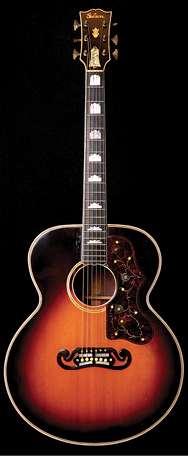
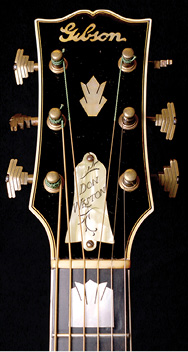
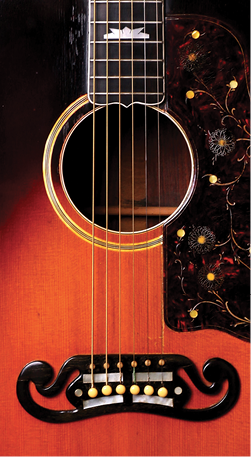
Gibson 1940 Rosewood J-200. (Photos by Jen Angkahan)
I guess the same will happen to me someday, but there won’t be any mystery about why I collected all these instruments—I was, and always am, in pursuit of the best.
I was sad about Don’s wife passing away, but I could hardly contain myself by the prospect of buying all those amazing guitars. Don’s son asked if I could come right over because he wanted me to see the extent of the collection and see if we could make a deal. A rocket ship couldn’t have gotten me over there faster!
When I got there, I discovered that the collection was a lot more massive than I originally thought. This dude collected a variety of stuff, not just guitars.
There were early Washburn presentation model guitars, an early Ditson guitar made by Martin, lots of Martin guitars of all sizes from early New York models, to literally hundreds of ukuleles of all descriptions, including dozens of Koa Martin ukes from the thirties. This was before the recent ukulele boom, and there was not a lot of interest in them at the time. Yes, Don had been a very active collector for decades.
I went through everything and bought every music-related item that was quality, which was considerable. Don was very finicky in his tastes. Finally, we were down to the last numbers, and his son threw in his collection of straight-edged razors, which all had ornate, hand-carved ivory or silver handles, and we had a deal. I should’ve bought his extensive gun collection, but I didn’t really know anything about them and still don’t.
Luckily, I had been saving and had money at the time, but I knew I would have to tell Don’s son I could give him almost all of the money immediately and the rest in a postdated check, giving me some time to sell some of the instruments to make good on my commitment. I had to wholesale a number of instruments to cover my debt quickly. After a couple of weeks, I accumulated enough money to cover the postdated check. Even though this was the mid-eighties and instruments were only bringing a fraction of today’s prices, it still amounted to a lot of bread. Don’s son was well aware of the market values at the time but also knew it was advantageous to sell so many instruments at once. When the smoke cleared, it was by far the biggest and best deal I had ever made.
And I had that once-in-a-lifetime Rosewood J-200.
I have a friend named Andy Roth who was living in LA at the time but has since moved to Hawaii. He was very much into ukes, and I sold them to him by the box load at prices that today would seem unbelievably cheap. There were loads of Martins, Gibsons, and Gretschs, as well as Nunes, Kamakas, and other Hawaiian ukes. There were National and other resonator ukes, pineapple ukes, and one uke that was given to Mickey Rooney by the mayor of Honolulu. I practically sold them by the pound. I wasn’t that much into them and liquidated them accordingly.
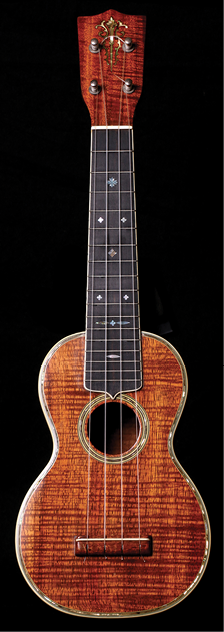
Martin uke. (Photo by Jen Angkahan)
A childhood friend of mine named Richard Glick purchased my Ditson presentation model guitar, which was by far the fanciest parlor guitar I have ever seen. Along with massive and intricate pearl inlays, there was also silver inlaid on the gorgeous pattern on the fingerboard.
I sold a lot of instruments at the time that I now regret, including Gibson L-5s, Stratocasters, the Ditson, and some great Gretsch instruments, but it’s important to keep your cash flowing to stay in business. I guess I have to keep in mind that at the time I sold them the prices were fair, but it seems like nothing compared with today’s prices. Like all business dealings from real estate, to stocks, to automobiles, everything is in the timing.
You might ask what happened to that Rosewood J-200. Like so many wonderful guitars in my collection, I sold that to a good friend and collector who shall remain nameless. I immediately regretted doing this. I attempted to buy it back for many, many years. I am nothing if not persistent. Finally, after twenty years, he let me have it. A couple weeks later, he called me up and told me he couldn’t live without it . . . So, the beat goes on.
I understand his predicament entirely. I just have to keep on reminding myself, “You can’t take it with you.” Don Weston taught me that lesson. So, upon my death, when my family finds all those old-school straight razors, now they’ll know I wasn’t too crazy. I have them for a reason . . .